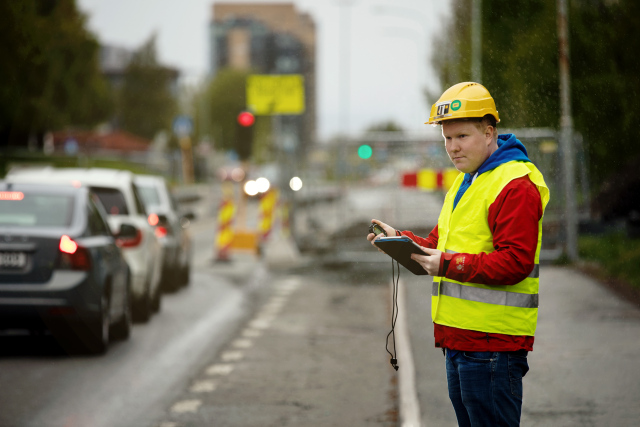IBM - Road, Rail and Transport
Road, Rail and Transport

What is Road, Rail and Transport?
Our research deals with everything from the ground the infrastructure is built on to the decisions made by those who travel by road and railway.
Society depends on reliable and safe infrastructure for the transportation of people and goods, we are actively engaged in research dealing with the construction, maintenance, and renovation of all types of civil infrastructure and the transportation networks that connect this infrastructure. Process and the use of spatial information are also involved in this group through geomatics. This technology provides for the development of maps, GPS and accurate data for modeling the construction of new roads and railways.
Active Research Projects
TRACE is a recearch center inlcuded in Transport 2050. The project is scheduled to start in fall 2025 and will continue for eight years. The centre is lead by SINTEF with NTNU as an important research partner.
NATURE-DEMO focus on how we can use natur based solutions(NbS) to protect infrastructure against the consequencs of climate change. The project is funded by the EU and coodinated from Tsjekkia and NTNU as partner.
Rehabilitation of low-volume county roads is a joint effort between NTNU, SINTEF, and 14 of the Norwegian counties to develop methods and knowledge to improve maintenance and rehabilitation of these roads. The project includes two PhD-projects
SENAVIS «Sensortechnology for smart de-icng» developes, in cooperation with Mittuniversitetet in Sweden, improved methods for measuring salt and other anti-icing chemicals.
By measuring residual salt in real-time we can contribute to more precise salting and reduced consumption of salt and chemicals. SENAVIS funded by EU Interreg in partnership with Trøndelag county and Avinor.
The aim for Smartchemistry is to improve decision support for winter maintenace of airport runways. In co-operation with SINTEF, Meteorological institute and Avinor we will develop and pilot a ny descission suport modul for sustainable use of chemicals on runways. To achieve this we need to understand the interaction between weather, winter operations and air traffic.
The project «Automatic condition mapping of county roads» will develop knowledge, methods and models for fully automated condition mapping of low-volume roads. By using AI we interpret road images and develop models for automatic quality assurance and evaluation of road sections.
GreeNexUS is a MSCA-doctoral network funded by EU, where 10 PhD fellows research and are trained to promote green urban areas and are rehabilitaition including safety, accesability and walkability. Our research group is involved in to sub-projects: ACCESSALL og 4SEENGrip
In the project "Simulation of winter services (VinterSim) we develop knowledge and models to simulate winter operations. By analysing historic weather and production data from snow removal vehicles we have develop geographical models able to predict how many operations that should be expected based on the selected standard, traffic volume and historic weather data.
Green-move focus on how we can move agricultural soils in connection to building of transport infrastructure. The project is funded by the Norwegian Research Council and are led by NTNU in cooperation with NMBU and SINTEF and a wide range of partners from public and private organisations.
FRESH (FREight-SHopping nexus in urban outskirts and beyond) is a research project, funded by DUT (Driving Urban Transition Partnership) and national funders, focussing on shopping-related mobility behaviour and urban logistics in Dortmund, Paris and Trondheim.
SmartRVU is an NTNU project organized within the Green2050 initiative. The project aims to develop improved method for travel surveys.
MoST (Mobility lab for greater Trondheim). Central aspects includes combination of different transport modes in a single journey, increase public transport and bicycle transport and development of good insitaments to promote change.
NU-COAST is an interdisciplinary research program that aims to develop coastal adaptation strategies to address climate change in Nunavut, Canada, through the creation of new technological tools and resources to support Inuit communities. The program is funded by Natural Resources Canada and is led by Université du Québec à Rimouski (UQAR), with the Norwegian University of Science and Technology (NTNU) as a partner.
EduPermaGR is a project funded by UArctic that aims to develop an interdisciplinary higher education course on permafrost, disseminating the latest scientific and technological knowledge in active collaboration with the community of Sisimiut, Greenland. The course will be taught at the Arctic DTU campus from April 15 to May 29, 2026, by a Nordic team of lecturers from the Technical University of Denmark (DTU), Umeå University, Aalborg University, Aarhus University, the University of Oslo, and NTNU.
The PermaIntern project is funded by the Danish Agency for Higher Education and Science (DAHES) as a UArctic network project. It is a consortium of nine Nordic universities that designed and implemented a new permafrost internship program in the Arctic (permaintern.org). To expand the program beyond Northern Europe, the SEDNA project was established in collaboration with international partners and is funded by Memorial University and UArctic through the Global Arctic Leadership Initiative – Indigenous and Northern Collaborative Research and Education Fund (Canada).
